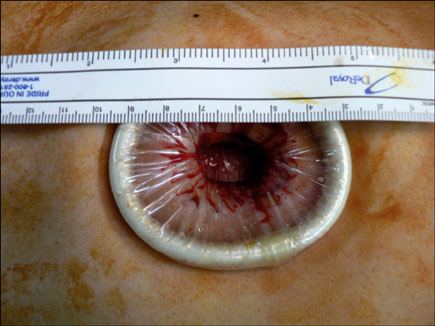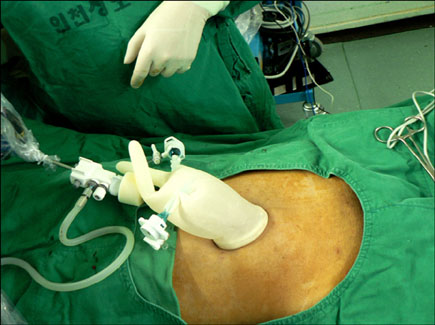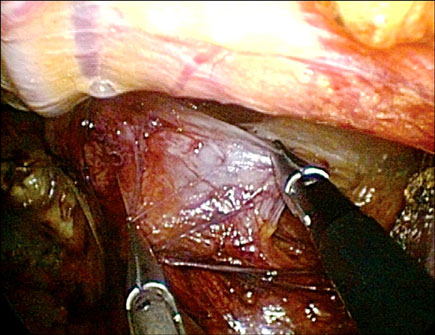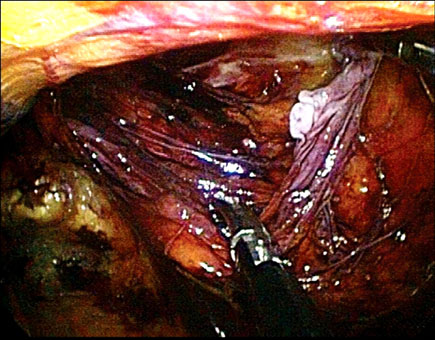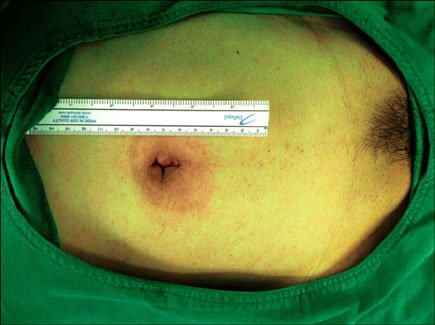J Korean Surg Soc.
2011 Nov;81(5):339-343. 10.4174/jkss.2011.81.5.339.
Initial experience of single port laparoscopic totally extraperitoneal hernia repair: nearly-scarless inguinal hernia repair
- Affiliations
-
- 1Department of Surgery, Incheon St. Mary's Hospital, The Catholic University of Korea School of Medicine, Incheon, Korea. parksm@catholic.ac.kr
- KMID: 2096688
- DOI: http://doi.org/10.4174/jkss.2011.81.5.339
Abstract
- PURPOSE
In the early 1990's laparoscopic hernioplasty gained popularity worldwide. Thereafter, laparoscopic surgeons have attempted to improve cosmesis using single port surgery. This study aims to introduce and assess the safety and feasibility of single port laparoscopic total extraperitoneal (TEP) hernia repair with a nearly-scarless umbilical incision.
METHODS
Sixty three single port laparoscopic TEP hernia repairs were performed in sixty patients from June 2010 to March 2011 at Incheon St. Mary's Hospital, with the use of a glove single-port device and standard laparoscopic instruments. Demographic and clinical data, intraoperative findings, and postoperative course were reviewed.
RESULTS
Of the 63 hernias treated, 31 were right inguinal hernias, 26 were left inguinal hernias and 3 were both inguinal hernias. There was one conversion to conventional three port laparoscopic transabdominal preperitoneal hernioplasty. Mean operative time was 62 minutes (range, 32 to 150 minutes). There were no intraoperative complications. Postoperative complications occurred in two cases (wound seroma and urinary retension) and were successfully treated conservatively. Mean hospital stay was 2.15 days.
CONCLUSION
Single port laparoscopic TEP hernia repair is safe and feasible. Umbilical incision provides an excellent cosmetic outcome. Prospective randomized studies comparing single port and conventional three port laparoscopic TEP repairs with short-term outcome and long-term recurrence rate are needed for confirmation.
Keyword
MeSH Terms
Figure
Reference
-
1. Lichtenstein IL, Shulman AG, Amid PK, Montllor MM. The tension-free hernioplasty. Am J Surg. 1989. 157:188–193.2. Spaw AT, Ennis BW, Spaw LP. Laparoscopic hernia repair: the anatomic basis. J Laparoendosc Surg. 1991. 1:269–277.3. Corbitt JD Jr. Laparoscopic herniorrhaphy. Surg Laparosc Endosc. 1991. 1:23–25.4. Memon MA, Cooper NJ, Memon B, Memon MI, Abrams KR. Meta-analysis of randomized clinical trials comparing open and laparoscopic inguinal hernia repair. Br J Surg. 2003. 90:1479–1492.5. Malangoni MA, Rosen MJ. Townsend CM, Beauchamp RD, Evers BM, Mattox KL, editors. Hernias. Sabiston textbook of surgery: the biologic basis of modern surgical practice. 2007. 18th ed. Philadelphia: Saunders Elsevier;1165–1167.6. Lowham AS, Filipi CJ, Fitzgibbons RJ Jr, Stoppa R, Wantz GE, Felix EL, et al. Mechanisms of hernia recurrence after preperitoneal mesh repair. Traditional and laparoscopic. Ann Surg. 1997. 225:422–431.7. Lee YS, Kim JH, Moon EJ, Kim JJ, Lee KH, Oh SJ, et al. Comparative study on surgical outcomes and operative costs of transumbilical single-port laparoscopic appendectomy versus conventional laparoscopic appendectomy in adult patients. Surg Laparosc Endosc Percutan Tech. 2009. 19:493–496.8. Hong TH, You YK, Lee KH. Transumbilical single-port laparoscopic cholecystectomy: scarless cholecystectomy. Surg Endosc. 2009. 23:1393–1397.9. McCormack K, Wake BL, Fraser C, Vale L, Perez J, Grant A. Transabdominal pre-peritoneal (TAPP) versus totally extraperitoneal (TEP) laparoscopic techniques for inguinal hernia repair: a systematic review. Hernia. 2005. 9:109–114.10. Leibl BJ, Jäger C, Kraft B, Kraft K, Schwarz J, Ulrich M, et al. Laparoscopic hernia repair--TAPP or/and TEP? Langenbecks Arch Surg. 2005. 390:77–82.11. Goswami R, Babor M, Ojo A. Mesh erosion into caecum following laparoscopic repair of inguinal hernia (TAPP): a case report and literature review. J Laparoendosc Adv Surg Tech A. 2007. 17:669–672.12. Lange B, Langer C, Markus PM, Becker H. Mesh penetration of the sigmoid colon following a transabdominal preperitoneal hernia repair. Surg Endosc. 2003. 17:157.13. Bringman S, Blomqvist P. Intestinal obstruction after inguinal and femoral hernia repair: a study of 33,275 operations during 1992-2000 in Sweden. Hernia. 2005. 9:178–183.14. Macdonald ER, Ahmed I. "Scarless" laparoscopic TAPP inguinal hernia repair using a single port. Surgeon. 2010. 8:179–181.15. Surgit O. Single-incision Laparoscopic surgery for total extraperitoneal repair of inguinal hernias in 23 patients. Surg Laparosc Endosc Percutan Tech. 2010. 20:114–118.16. Agrawal S, Shaw A, Soon Y. Single-port laparoscopic totally extraperitoneal inguinal hernia repair with the TriPort system: initial experience. Surg Endosc. 2010. 24:952–956.17. He K, Chen H, Ding R, Hua R, Yao Q. Single incision laparoscopic totally extraperitoneal inguinal hernia repair. Hernia. 2011. 15:451–453.18. Dulucq JL, Wintringer P, Mahajna A. Laparoscopic totally extraperitoneal inguinal hernia repair: lessons learned from 3,100 hernia repairs over 15 years. Surg Endosc. 2009. 23:482–486.
- Full Text Links
- Actions
-
Cited
- CITED
-
- Close
- Share
- Similar articles
-
- To Minimize Post-operative Pain in Inguinal Hernia Repair: Single-port Laparoscopic Totally Extraperitoneal Inguinal Hernia Repair without Fixation of the Mesh
- Totally Extraperitoneal Laparoscopic Repair of Obturator Hernia withPartial Intestinal Obstruction
- SUTI (Single Umbilical Tangential Incision) Laparoscopic TEP Inguinal Hernia Repair
- Laparoscopic totally extraperitoneal repair without suprapubic port: comparison with conventional totally extraperitoneal repair
- Prevention and management of intraoperative complication during single incision laparoscopic totally extraperitoneal repair

